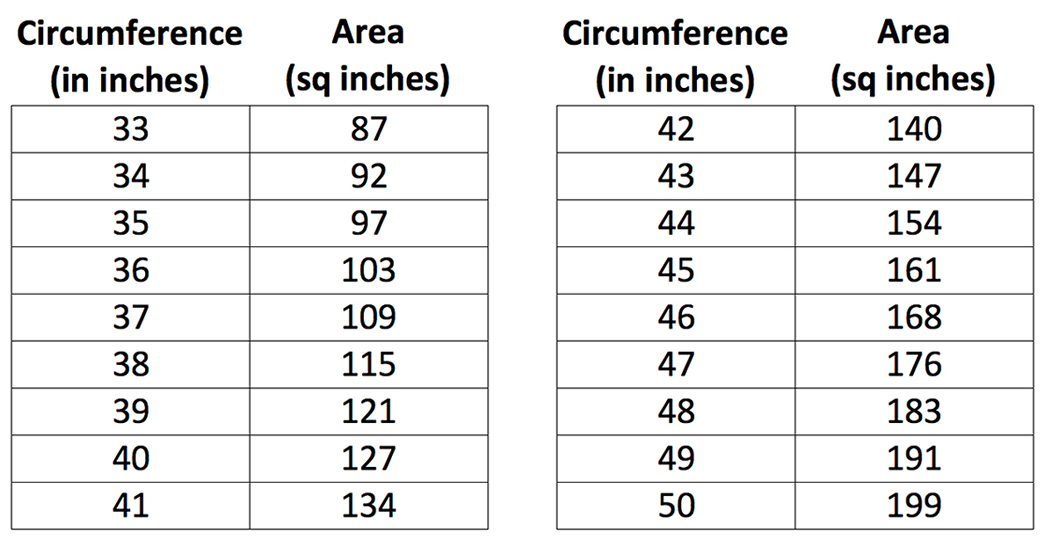
Notes below on how I'm showing just how big, or small, the packs are.
Comparing different brands of packs by using their circumferences is a more accurate way to compare them than comparing manufacturers stated volumes because there is no standard for measuring volumes. An LBP 37 for instance is 37" in circumference at the top while a Super Sarc is 42". If you have a pack that tapers, that is different volumes at different sections, you can break it into sections to do the math below. In general though you can just take a section midway up a pack to get started. Most McHale packs do not taper these days and are the same circumference top to bottom.
To help you figure volumes of various pack bags here is a chart showing the cross-section volume of various circumferences: Simply multiply these cross-section numbers by the pack length or height of the load. If your pack is 33" around like on the first line of the chart, multiply that by the height of the bag. Say the height of the bag is 25", multiply 87" by 25" and that's the bag volume which is 2,175 cubic inches. On Google that converts to about 35.5 Liters.

Just pull your packs circumference from the chart above and multiply it by whatever height number you want. Our LBP 36 (36" circumference) to the top of say the shouldern height section of the main frame, a 23" frame is; 23 x 103 = 2369 cuin. It's maximum bag height would be about 40". That's; 40 x 103=4120 cuin. But, that leaves no bag to draw up with the drawstring. A 30" height is more reasonable; 30 x 103=3090 cuin. The P&G Bayonets typically add 5" and 6" for large volume packs. Let's just add 6" to that 23" frame and we get 29" of course. Volume to the top of the bayonets is then 29" x 103" = 2987 cuin.
Here is the math, below, that gets the numbers that go into the chart above:
To get the volume of your current pack: Measure the circumference with a tape. If it is 38" divide 38 by 3.14 (Pi). That = 12.12. That is the Diameter of the pack. Divide this by 2. That gives the radius of the pack which is 6.05. To get the cross section area of any pack just multiply the radius by itself ( in this case 6.05 x 6.05 ) and then mutiply that by 3.14; 6.05 x 6.05 x 3.14 = 114.93" The radius is always mutiplied by itself and always by 3.14. To get the volume of the pack or the load, multiply the cross-sectional area by the length of the load or the pack bag, whichever you are trying to figure. In this case the cross-section is 114.93". Let's say the length of the pack bag to the top of the drawstring is 25". The volume would be 114.93 x 25 = 2873.25"
It gets a bit more complicated with packs that taper. The easiest thing to do with say a pack that is 40" long that tapers, is to divide it into 3 equal height cross-sections, measure the circumference of each 13" tall cross section, and then consult the chart and then add the sections together.
The volumes info I have posted is mostly so that people can compare different packs and different brands on a relative basis. If somebody has a pack they like the volume of and want to get a similar volume pack from us, then they can use these ' tools' without even getting the actual volume numbers. It is also a way to compare any pack with another on the open market without having to rely on what the manufacturer says the volume is. The method of listing circumference numbers could become some kind of standard like listing cubic inches, or liters.
When you figure the volume of a pack with the cylindrical formula method, that only represents it's maximum possible volume. When packs are packed the most efficiently, flatter against the back in more of a rectangular shape, they actually have less volume. For now, the quickest way to compare any two packs is simply to get the tape measure out. To be safe do not rely on stated volumes when comparing different brands.